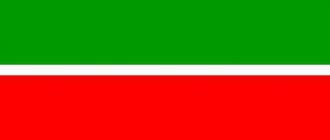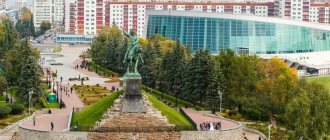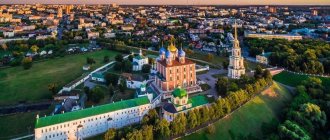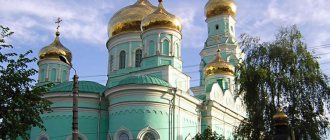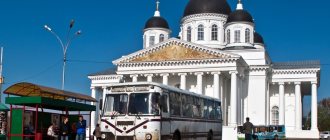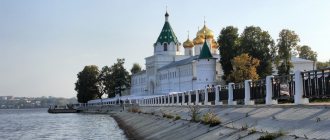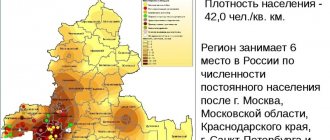Kuznetsk is a city in the Penza region of Russia. It has regional significance and forms the Kuznetsk urban district. The population is 83,400 people. It is located in central Russia, in the east of the Penza region. Its height is 254 meters above sea level. This is due to the influence of the Volga Upland. The Truev River flows through the city.
The area of the city is 2287 hectares. The population of Kuznetsk is gradually decreasing.
Natural conditions
Kuznetsk is located on a hill in central Russia. The climate is temperate, with an annual precipitation of 627 mm. Winters are cool. The lowest average temperature is observed in February - 9.8 °C. The average annual temperature is + 5.3 °C. Summer is moderate. Precipitation at this time of year is often showery.
The city is located in a forest zone. To the north of the city borders there is a coniferous forest. No serious deposits have been discovered in this district. There are natural oil deposits. The most widespread are sands, sometimes peat bogs. There are places where clays, loams, and mineral dyes occur.
To the north of the city there is a nature reserve: the Volga forest-steppe.
Main attractions
What are they?
- Church of the Resurrection of Christ. This brick temple was built in the middle of the last century. It is a work of ancient Russian architecture.
- Memorial complex "Hill of Military Glory". The opening took place in 1975 on the occasion of the fortieth anniversary of the Victory over fascism. There is a sculpture in the form of three soldiers made of granite. The Victory Banner is installed nearby.
- Women's gymnasium. It was erected in the second half of the century before last and is a two-story brick building. During the period of hostilities, the headquarters of the Tenth Army was located there.
Population of Kuznetsk
The number of inhabitants has been counted since 1618. At that time, only 10 people lived in this place. At that time these were separate courtyards, which later formed a village called Truevo. In 1718, the number of households was 300. And already in 1780, despite the modest number of inhabitants, the village was renamed the city of Kuznetsk. This was associated with the development of blacksmithing and other crafts. An iron foundry and a leather processing plant were opened here. And in 1874, a railway station of the Morshansko-Syzran railway appeared.
Before 1897, the number of city residents was small and fluctuated from year to year. In 1860 there were only 962 people, although a year earlier there were 12,828. However, in 1897 there were already 20,473 inhabitants, then the population basically only grew. The process proceeded very quickly until 1973, and then population growth slowed sharply. In 1973 there were 90,000 inhabitants. In 1991 there were already 100,000 people, after which the growth stopped. A decline began in 1996, which continues to this day. In 2022 there were 83,400 inhabitants. Every year their number decreases by about 1000 people.
Now Kuznetsk is in 202nd place among other cities of the Russian Federation. The population density in the city is 2025.5 people/km2.
Map
| Kuznetsk: maps |
Kuznetsk: photo from space (Google Maps) Kuznetsk: photo from space (Microsoft Virtual Earth)
| Kuznetsk. Nearest cities. Distances in km. on the map (in brackets along roads) + direction. Using the hyperlink in the distance , you can get the route (information courtesy of the AutoTransInfo website) | |||
| 1 | Yevlashevo | 15 () | IN |
| 2 | Sosnovoborsk | 30 (49) | NW |
| 3 | Neverkino | 38 (40) | YU |
| 4 | Nikolaevka (Ulyanovsk region) | 40 (41) | IN |
| 5 | Russian Kameshkir | 43 (42) | SW |
| 6 | Middle Eluzan | 44 (49) | Z |
| 7 | Chaadaevka | 46 (52) | Z |
| 8 | Sursk | 60 (71) | Z |
| 9 | Pavlovka (Ulyanovsk region) | 60 (94) | SE |
| 10 | Settlement | 62 (72) | Z |
| 11 | Barysh | 68 (117) | NE |
| 12 | Bazarny Syzgan (Ulyanovsk region) | 71 (146) | WITH |
| 13 | Baltai (Saratov region) | 72 (72) | YU |
| 14 | Nikolsk | 74 (103) | NW |
| 15 | Lopatino | 76 (71) | SW |
| 16 | Novospasskoe (Ulyanovsk region) | 76 (78) | IN |
| 17 | Staraya Kulatka (Ulyanovsk region) | 80 (136) | SE |
| 18 | Inza | 83 (152) | WITH |
| 19 | Shemysheyka | 84 (171) | Z |
| 20 | Kuzovatovo (Ulyanovsk region) | 86 (125) | NE |
| 21 | Svobodny (Saratov region) | 88 () | YU |
| 22 | Radishchevo (Ulyanovsk region) | 89 (115) | IN |
| 23 | Starotimoshkino (Ulyanovsk region) | 90 () | NE |
| 24 | Suitcase | 90 (105) | Z |
| 25 | Bazarny Karabulak (Saratov region) | 94 (105) | YU |
| 26 | Zarechny | 95 (126) | Z |
| 27 | Zasechnoe | 101 () | Z |
| 28 | Lunino | 104 (166) | NW |
| 29 | Penza | 105 (120) | Z |
| 30 | Bessonovka | 106 (138) | Z |
| 31 | Grabovo | 106 (147) | Z |
a brief description of
Located in the central part of the Volga Upland, on the river. Truev (tributary of the Sura), 121 km east of Penza. Railway station.
Kuznetsk is the second largest and most important city in the region.
Territory (sq. km): 42
Information about the city of Kuznetsk on the Russian Wikipedia site
Historical sketch
Originated at the end of the 17th century. like the village of Truevo on the banks of the river. Truev; hydronym of pre-Russian origin with the Old Mordovian formant -yov “water, river”. In 1699, a church in the name of the Resurrection of Christ was erected in the village, after which it became the village of Truevo-Voskresenskoye. In the 18th century It is called Naryshkino after the owner's surname.
In 1780, it was transformed into a district town of the Saratov governorship and, due to the relative development of the blacksmith industry in it, was renamed Kuznetsk. Since 1797 in the Saratov province.
In 1856, in the district town of Kuznetsk, Saratov province, there were 4 churches, 1699 houses, 122 shops.
Municipal indicators
| Index | 2001 |
| Demography | |
| Number of births, per 1000 population | 7.2 |
| Number of deaths, per 1000 population | 16 |
| Natural increase (decrease), per 1000 population | -8.8 |
| Standard of living of the population and social sphere | |
| Average monthly nominal accrued wages, rub. | 1497 |
| Average housing area per inhabitant (at the end of the year), sq.m. | 17.8 |
| Number of preschool institutions, pcs. | 23 |
| Number of children in preschool institutions, thousand people | 2.9 |
| Number of daytime educational institutions (at the beginning of the school year), pcs. | 18 |
| Number of students in daytime educational institutions, thousand people | 11.8 |
| Number of doctors, people. | 329 |
| Number of nursing staff, people. | 1235 |
| Number of hospital institutions, pcs. | 7 |
| Number of hospital beds, thousand units | 1.1 |
| Number of medical outpatient clinics, pcs. | 9 |
| Capacity of medical outpatient clinics, visits per shift, thousand units. | 1.7 |
| Number of registered crimes, pcs. | 796 |
| Persons who committed crimes were identified, persons. | 615 |
| Economy, industry | |
| Number of enterprises and organizations (at the end of the year), pcs. | 2903 |
| Construction | |
| Volume of work performed by type of activity “Construction” (until 2004 - volume of work performed under construction contracts), million rubles. | 31.2 |
| Commissioning of residential buildings, thousand sq.m. of total area | 9 |
| Commissioning of residential buildings, apartments | 119 |
| Commissioning of preschool institutions, places | 0 |
| Commissioning of educational institutions, places | 0 |
| Commissioning of hospital facilities, beds | 0 |
| Commissioning of outpatient clinics, visits per shift | 0 |
| Transport | |
| Number of bus routes (in intracity traffic), pcs. | 8 |
| Number of passengers transported by buses per year (in intracity traffic), million people. | 5.7 |
| Connection | |
| Number of residential telephone sets of the city public telephone network, thousand units. | 13.8 |
| Trade and services to the population | |
| Retail trade turnover (in actual prices), million rubles. | 1091.8 |
| Retail trade turnover (in actual prices), per capita, rub. | 11349 |
| Public catering turnover (in actual prices), million rubles. | 24.1 |
| Volume of paid services to the population (in actual prices), million rubles. | 372.4 |
| Volume of paid services to the population (in actual prices), per capita, rub. | 3871 |
| Volume of household services to the population (in actual prices), million rubles. | 9.9 |
| Volume of household services to the population (in actual prices), per capita, rub. | 103 |
| Investments | |
| Investments in fixed assets (in actual prices), million rubles. | 98.5 |
| Share of investments in fixed assets financed from budgetary funds in the total volume of investments, % | 0 |
Data sources:
- Regions of Russia. Main characteristics of the constituent entities of the Russian Federation: statistical collection. Goskomstat of Russia. - M:, 2003.
Culture, science, education
In the village of Radishchevo, 17 km south of Kuznetsk, there is the A.N. Local Lore Museum. Radishcheva.
Universities of the city
Kuznetsk Institute of Information and Management Technologies (branch) of Penza State University
442537, Penza region, Kuznetsk, st. Mayakovsky, 57-A WWW: https://www.kiiut.ru/
Museums, galleries, exhibition halls
State Literary and Memorial Museum of A.N. Radishchev 442514, Penza region, Kuznetsk district, p.
Radishchevo Phone(s): 4-6449 Kuznetsk Museum of Local Lore 442500, Penza region, Kuznetsk, st. Lenina, 270 Phone(s): 4-2551
Architecture, sights
Church of the Ascension of Christ (1842-56).
| Population by year (thousands of inhabitants) | |||||||
| 1856 | 11.8 | 1973 | 90 | 2001 | 96.6 | 2014 | 86.2 |
| 1897 | 20.5 | 1976 | 91 | 2003 | 92.1 | 2015 | 85.2 |
| 1913 | 26.5 | 1979 | 93.6 | 2005 | 90.3 | 2016 | 84.3 |
| 1926 | 30 | 1982 | 95 | 2006 | 89.5 | 2017 | 83.4 |
| 1931 | 31.1 | 1986 | 97 | 2007 | 88.9 | 2018 | 82.3 |
| 1939 | 37.8 | 1989 | 98.6 | 2008 | 88.3 | 2019 | 81.0 |
| 1959 | 56.9 | 1992 | 100.6 | 2010 | 87.3 | 2020 | 80.5 |
| 1962 | 64 | 1996 | 99.7 | 2011 | 88.8 | 2021 | 79.8 |
| 1967 | 75 | 1998 | 98.3 | 2012 | 88.0 | ||
| 1970 | 84.1 | 2000 | 97.5 | 2013 | 87.2 | ||
Latest job center vacancies
The city requires workers in a variety of specialties. Lots of engineering vacancies. There are vacancies for PC operator. Salaries start from 11,163 rubles. There are quite a lot of vacancies at this salary. Most often these are various working specialties.
More expensive vacancies with a salary of up to 30,000 rubles, but most often in the region of 20 - 25 thousand rubles. Basically, these are vacancies in the service sector: managers, PC operators, administrators, customer service and others.
All this data is for June 2022.
The history of the city of Kuznetsk from the very beginning
Industrial development of Kuznetsk
1925 for Kuznetsk was a year of revival that began in all spheres of the economy, culture and public life. During these years, handicraft industry played a significant role in the city's economy. Much attention was paid to its development.
The reason for special attention to the handicraft industry at that time was the lack of goods produced by large-scale industry. The handicraft industry was supposed to fill this deficiency.
The city's handicraft industry was varied. There were up to 5,000 real artisans in the city, in addition there were those for whom handicrafts were auxiliary. The city handicraft industry produced more than 3 million rubles worth of products per year.
The issue of rebuilding a new power plant began to be raised in the city back in 1925.
The issue of building a new power plant in Kuznetsk was finally resolved in 1928.
In July 1928, by decree of the All-Russian Central Executive Committee of the RSFSR, the Middle Volga region was formed, which included eight districts, including Penza, Kuznetsk, Mordovian, Syzran and other districts.
Having become the center of the district, Kuznetsk had the same administrative significance as Penza. The issue of further electrification of the city was raised at a new level. And so in November 1928, the Presidium of the Middle Volga Regional Executive Committee decided to build a power plant in Kuznetsk. Five years later, in September 1933, the Kuznetsk power plant with a capacity of two thousand kilowatts produced its first current.
In the twenties and thirties, the city's economy was characterized by an increase in the capacity of industrial enterprises based on their expansion. Handicraft artels also strengthened and expanded.
In 1928, the brick factory, for example, produced 700,000 bricks, and already in 1930, thanks to the expansion of the plant, one and a half million bricks were produced.
In November 1927, it began producing textile machines and spare parts for them. In the same year, a mechanical workshop with an area of 854 square meters was built. meters. In 1929, the foundry area was expanded due to construction.
The following enterprises played an important role in the city's industry in the late 20s and early 30s: a sheepskin and fur factory, a tannery (the main product is glue), a rope and twine factory, a mill management plant (grain processing), a city industrial plant (the main product is felt boots ), leather primary processing plant (POKS). These enterprises employed about a thousand people.
In 1937, a fur and clothing factory was added to the sheepskin and fur factory, and the plant was renamed the state sheepskin and fur factory.
Artels played a significant role in the city’s economy during this period. In the twenties, they united most of the Kuznetsk handicraftsmen, and already in the thirties they were small workshops or semi-handicraft industrial enterprises, producing mainly products for mass demand.
The 12 Years of October artel employed about 250 people. Shoes were made here. The Molot artel (about 150 people) produced beds, construction nails, and shovels. The “Fighter for Quality” artel (about 120 people) sewed and repaired shoes. Felt boots were produced in the “Red Fuller” artel (about 160 people). The Kirov Artel (about 120 people) produced rope; they also engaged in individual tailoring and clothing repair.
Other artels also worked: “Stakhanovets” (about 30 people, the main products are hard leather goods, saddlery), “Stroitel” (about 20 people, the main products are mirrors, tables), named after Chelyuskintsev (about 20 people, the main products are mattresses ), “Baker” (about 50 people, the main products are bakery and confectionery products), “Khimprom” (about 60 people, the main products are soap, drying oil, wheel ointment), “Utilprom” (about 30 people). At this time, there also existed the “Carrier” artel, the trade and production artel of disabled people “Red Invalid” and other artels uniting small groups of former single artisans.
The twenties and thirties for Kuznetsk were not only a time of economic development. During this period, truly revolutionary transformations take place in all spheres of life. Let's turn to Figures and Facts.
In 1925, there were twelve schools of the first and second levels in the city with a total number of students of 2,380 people.
In February 1925, in Kuznetsk, at the central library, a circle of friends of books was organized, then consisting of 40 people. He was engaged in distributing literature to the masses. The number of library subscribers at that time was 2,155 people.
In 1926, there were 10 literacy centers in the city (156 centers in the district). They were located at the central library, the Peasant's House and the city theater.
Large educational activities and scientific research work were carried out by the Kuznetsk branch of the Lower Volga Local History Society, created in April 1926. Its organizers were great enthusiasts of studying the history of their native land I.V. Klestov, M.I. Chinaev, S.M. Bolshakov. They were also the organizers of a scientific and industrial exhibition in Kuznetsk, which was opened back in 1923. The exhibition presented samples of industrial and handicraft products produced in the city. In October 1926, the exhibition came under the jurisdiction of the executive committee and received the name “Museum of the Local Region.” And in March 1927, the museum was named after A.N. Radishchev.
In the second half of the twenties, radioification of the city and county began. In November 1927, the first transmission of Penza radio broadcasting took place, and a year later, in November 1928, its own radio center was built in Kuznetsk. In November of the same year, the first district conference of radio workers took place.
In 1928 - after the formation of the Kuznetsk district of the Middle Volga region, instead of the newspaper “Peasant Life”, the newspaper “Trudovoy Put” began to be published - the organ of the Kuznetsk district committee of the CPSU (b), the regional trade union bureau and the city council. The newspaper was published three times a week. Its circulation in 1929 was 6,100 copies, in 1930 - 11,000 copies.
The district newspaper Trudovoy Put existed for only two years. On August 10, 1930, the first issue of the newspaper “Stalinsky Klich” was published in the city - the organ of the Kuznetsk district party committee and the district executive committee of the Middle Volga region. In 1940, “Stalinsky Klich” became a city newspaper, and the printed organ of the district party committee and the district executive committee received the name “Stalinets”.
In the thirties, several large-circulation newspapers were published in Kuznetsk. Among them: “Udarnik” at the sheepskin and fur factory, “Hammer of October” in the “Hammer” artel, “Sewing worker” in the artel of sewing workers.
In 1928, a population census took place in Kuznetsk. Its results were reported by the Trudovoy Put newspaper in the article “What the Population Census Showed” (No. 79 of November 1, 1928).
At this time the city was inhabited by 28,816 people. Of these, 13,434 are men, 15,382 are women.
During the census, the number of illiterate people is recorded. There were 2032 people aged from 17 to 35 years old, 1621 people from 36 to 50 years old, 2136 people over 50 years old. 2022 illiterate people from 17 to 35 years old were counted.
The fight against illiteracy was one of the top priorities at that time. The “Down with Illiteracy” society, which then existed in the city, took an active part in this struggle. In April 1929, a district congress of this society was held, at which the task was set to eliminate illiteracy in the city and district as soon as possible. Much work to eliminate illiteracy was carried out by teaching staff of schools and workers of cultural institutions of the city.
At the same time, the city was addressing issues of developing vocational education. In 1930, medical and pedagogical schools and a veterinary school were opened.
Two years later, a sheepskin and fur technical school began operating. Later the technical school began to be called a technological school, and since 1950 - a planning and economic light industry school.
In December 1936, the House of Pioneers and Schoolchildren was opened. It has created 10 clubs and organized a children's technical station with an aircraft modeling room.
In the thirties, extensive work was carried out to improve and plant trees in the city, which subsequently largely determined the appearance of the central part of modern Kuznetsk. The alleys surrounding Karl Marx Square today and the Komsomolets cinema were founded in 1935-1937.
Until 1930, the city bazaar was located on Karl Marx Square. In 1930, it was moved to Ilyinskaya Square (the current collective farm market No. 1).
In the early thirties, blacksmiths began to actively “settle” White Lake. The construction of urban pioneer camps and recreation areas began here. The lake became one of the favorite vacation spots.
In 1931, an attempt was even made to rename Kuznetsk to Beloozersk. Evidence of this is the following document:
“Minutes No. 28 of the meeting of the Presidium of the Kuznetsk District Executive Committee dated July 29, 1931.
We heard: about the renaming of the Kuznetsk district and the regional center (info. Artishchev).
Resolved:
1) In accordance with the instructions of the regional council on the need to rename the district, rename the Kuznetsk district and the district center, assigning the name Beloozersky for the district, and Beloozersk for the district center instead of the city of Kuznetsk.
2) The regional council asks for approval of this new name for the district and its center.
Chairman Artishchev.
Secretary Shchetinkin. (Kuznetsk City Archives. Fund No. 91. Case No. 8, sheet 262).
The regional executive committee did not approve this resolution of the presidium of the Kuznetsk regional executive committee, and Kuznetsk remained Kuznetsk.
One of the most significant events in the pre-war history of the city was the construction of the Kuznetsk shoe factory.
In the early thirties, the country already had its own shoe industry - the Leningrad Skorokhod factory, the Moscow Paris Commune factory, and a factory in Rostov-on-Don. In 1934, on the southwestern outskirts of the city, where at that time there was a vacant lot, construction of a shoe factory began. At that time, for Kuznetsk it was a gigantic construction site. Before this, in its entire history, Kuznetsk had never seen such a scale of construction. The following document gives a fairly complete picture of them:
“Kuznetsk shoe factory and the progress of its construction.” (Certificate from the annual report on capital investments and core activities for 1935).
“On January 16, 1934, the People’s Commissariat of Light Industry of the USSR authorized the construction of the Kuznetsk shoe factory with a capacity of six million pairs of shoes per year and a cost of 18,750 thousand rubles according to the general estimate. The following types of footwear are expected to be produced: ashlar for men and women, chrome for men and adhesive for women. Basically the shoes will be: 50 percent cowhide and 50 percent chrome.
For the construction of a factory and other cultural and community premises, as well as ancillary enterprises, a site near the railway, a distance of 1 kilometer from the city center, measuring 27 hectares, has been allocated. The main production building occupies an area of 3 hectares, and the remaining area is provided for the placement of cultural and social premises and auxiliary enterprises.
Construction of the facilities began in February 1934, and on May 18 of the same year, the foundation of the main production building was laid.
In 1934, construction covered the following objects: the main production building, a mechanical repair shop, a carpentry shop, a fuel and lubricants warehouse, a garage, a four-story residential building for engineering and technical workers with 32 apartments, a railway line, a temporary canteen, two residential barracks, a vegetable storehouse, purchased at a distance of six kilometers from the construction site there is a suburban farm with land availability of 650 hectares.
... With the construction of a giant light industry - a shoe factory - in Kuznetsk, the former Kuznetsk, inhabited by artisan shoemakers, turned into a city of light industry. This circumstance is confirmed by the following data: Kuznetsk currently has a population of 30 thousand people. With the launch and development of the factory there will be an increase in qualified shoe workers, engineering and technical workers and employees of up to 6 thousand people. This means that all handicraft shoemakers will be forced to go to the factory. And if we take into account that for every worker and employee of the factory there are 2 family members, then the giant under construction will unite around itself a team of 18 thousand people. Thus, half of the population of Kuznetsk will be assigned to the factory, and the rest will be assigned to such industrial enterprises as a sheepskin and fur factory, a rope factory, a primary processing plant for raw materials, a leather factory, and a fur and clothing factory. The city will turn into a light industrial area.
Director of construction management of the Moskovkin factory. (Kuznetsk city archive. Fund No. 261. Case No. 2, sheets 137-141).
Subsequently, not everything turned out as Moskovkin expected, but on the whole he was right. The factory made big changes in the life of the city. Kuznetsk, from a city with a diverse handicraft industry, began to turn into a city of rapidly developing light industry.
In 1937, two sewing lines came into operation at the factory. At first, the range of shoes was limited. On one thread, women's combined shoes with low heels were sewn. These shoes were made using the stitching method of fastening with an open, and later with a closed rice. The second stream produced men's and boys' low shoes with rubber soles.
In 1939, the third sewing flow started working.
The production of chrome and textile women's shoes with medium heels began. At the same time, the adhesive fastening method was mastered. Pages: First Previous 33 Next Last

